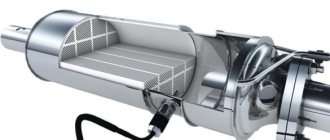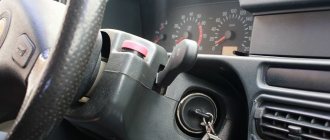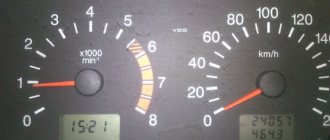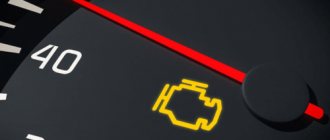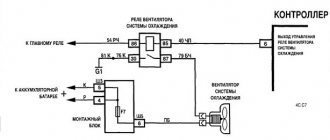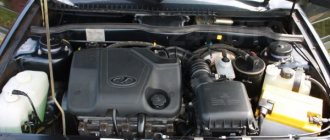VAZ-2114 cars, from the start of production, are equipped with eight-valve engines with a volume of 1.5 liters. Since 2007, they have been equipped with an eight-valve 1.6 liter engine with an environmental class of Euro-4. The operation of the car, sometimes incorrectly, brings “surprises” over time. The engine does not perform its functions at full power, and thrust decreases. Let's try to understand the causes and methods of elimination.
SIGNS AND REASONS OF “ADJUSTMENT”
Engine trouble: what is it, and what are the signs to identify this malfunction? You can understand that the internal combustion engine is malfunctioning by the following signs:
- At idle speed, the engine operates unevenly, jerking periodically;
- The car does not develop the required power when driving;
- The car drives jerkily, when you press the gas pedal, there are gaps in operation;
- The exhaust from the muffler is uneven, with interruptions, pops and shots are possible;
- Fuel consumption increases.
Increased fuel consumption hurts your pocket Reasons: There are many reasons why the engine misfires. There are such nuances that even experienced technicians do not immediately determine the nature of the malfunction. But the most common cylinder failures are the following (starting with the elementary ones):
- The candle does not work;
- The high-voltage wire is broken;
- The ignition coil has failed;
- The control unit is faulty;
- There is an air leak in the intake manifold;
- Exhaust valve burnt out;
- The cylinder head gasket is broken;
- The compression rings on the piston are broken,
- The piston itself has burned out, or the bridge on the piston between the compression rings has burst.
This article is about the VAZ 2114 car, so carburetor malfunctions are not considered, since this device was not installed on the 2114 model. This brand of car has a fuel system with distributed injection (injector), and the answer to the question of why the engine stalls may be hidden in this system.
Diagnostics
The first signal of problems with the engine is the lighting of the Check Engine indicator on the instrument panel. If the car has a standard on-board computer, then you can read the ignition system errors on it. But it is not able to show the operation of the device in real time, so a more accurate way to determine the fault code is a diagnostic tool that is connected to a special connector.
Regardless of the type of equipment to check, there are several main error codes that occur when a VAZ 2114 misfires:
- P0300 - a general problem in the system, the presence of numerous misfires on all cylinders;
- P0301 - malfunction of the spark plug of the first cylinder (cylinders are counted from the unit drive pulley);
- P0302 - problems with the functioning of the second cylinder;
- P0303 - problem in the third cylinder;
- P0304 - malfunction of the fourth cylinder.
Error 0302 Error 0304
VAZ 2114 ENGINE CHARACTERISTICS
The VAZ 2114 car is mainly equipped with an 8-valve 4-cylinder engine, the fuel system and ignition are controlled by an electronic unit (ECU). The electronics have many different sensors that inform the unit about the condition of the engine. The control unit, in turn, reads the necessary information and gives commands to those devices that directly affect the operation:
- Distributes the spark among the cylinders in a certain order;
- Determines the required amount of supplied fuel (leans or enriches the fuel mixture depending on the number of revolutions).
The electronic control system of the VAZ 2114 contains the following sensors:
- Crankshaft position sensor (CPS);
- Camshaft position sensor or phase sensor (DPRV);
- Idle air regulator (or sensor) (IAC);
- Throttle position sensor (TPS);
- Knock sensor (DS);
- Air flow sensor or flow meter (AFM);
- Lambda probe or oxygen sensor.
Failure of any of these sensors leads to unstable engine operation, and if the DPKV fails, the car most likely will not start at all. Fuel is supplied to each cylinder using an electronically controlled injector. A faulty injector can also cause poor engine performance.
conclusions
Maintenance, which should be carried out according to the manufacturer’s recommendations, will avoid many problems. The only question is where to go, at the “Kulibins”, or at specialized service stations equipped with the necessary equipment and equipment. The choice is up to the vehicle owner. The sooner the prerequisites for the failure of a particular part are identified, the less financial losses there will be in the future . It should be remembered that timely maintenance increases the safe operation of the vehicle.
Spark plug
We take a spark plug wrench and unscrew the spark plug, look at the condition of the electrode:
- brick color - indicates normal operation of the cylinder;
- smoked, with a little soot, etc. – indicates that the engine is not operating properly, either due to excess oil or too much fuel remaining.
Such deposits on the spark plug prevent it from working normally, and the spark is weak and irregular. Cleaning the spark plugs or replacing them will not help in this case, because... you need to look for the cause of the soot that appears: it could be.
- malfunction of the non-return (exhaust) valve (needs to be adjusted - if it is clamped, replaced - if it is burnt out);
- low compression in the cylinders (at least 10-10-10-10) - measure the compression correctly, make the appropriate repairs - most likely either your rings are stuck or the valves are burnt out;
- displacement of the valve timing - here either the timing belt is not installed correctly, or it has jumped off - the belt must be removed and reinstalled with phase adjustment;
- the injectors are overfilled - they need to be changed (how to replace the injectors?);
- low pressure in the fuel system (how to check the pressure?);
- The oxygen sensor readings are incorrect - you need to replace it;
- Carbon deposits can also appear when the engine is idling for a long time, if the spark plug has a non-standard heat rating - such spark plugs need to be replaced.
Pay attention to the white spark plug body: if there are black dots or stripes on it, it means the spark plug is broken and needs to be replaced.
Why doesn't the diesel engine run when it's hot?
Diesel engines are resistant to operation at high temperatures, including long-term operation. The main problem that a hot diesel engine does not run is the overheating of the fuel injection pump.
High pressure fuel pump
In turn, the high-pressure pump may overheat due to significant wear of its plunger pairs. To diagnose, you need to cool the pump with a hot engine using cold water. If after this the car starts well, it means that the pump is already on the verge of failure. An additional sign is that the car does not start well when hot.
In most cases, either replacing the pump with a new one or repairing the pump and replacing the plunger pair helps.
Ask in the comments. We will definitely answer!
REASONS FOR UNSTABLE OPERATION OF MOTOR 2114
Let's consider several standard situations that can happen with an 8-valve 4-cylinder engine.
UNSTABLE OPERATION ON A COLD ICE
It often happens that a VAZ 2114 stalls when cold, but as it warms up the engine levels out and starts working stably. There could be several reasons:
- The ECU sets the fuel mixture too rich to cold;
- The spark plug does not work, but when heated, the spark plug still “breaks through”;
- The high-voltage wires are damp or moisture has entered the ignition coil;
- Parts of the piston group are worn out.
UNSTABLE OPERATION OF A HEATED ENGINE
It also happens the other way around - a cold internal combustion engine operates more or less steadily, but as it warms up it begins to throttle. Usually the engine starts when hot because:
Lost engine thrust: why does this happen and what should the driver do?
As a rule, during the long-term operation of a vehicle, almost every driver sooner or later notices that the engine does not pull well. In other words, the power unit has difficulty coping with the loads, there is a loss of power, the unit needs to be cranked up to high speeds to maintain the usual pace, the car accelerates worse from a standstill, picks up speed slowly, etc.
At the same time, in many cases the engine runs smoothly, does not tremble, there are no increased vibrations, extraneous sounds, knocking or noise during operation of the internal combustion engine. Let us note right away that there is a fairly wide list of possible reasons why a warm engine does not run, and there is a loss of engine power when cold and/or when hot.
In this article we will talk about why the engine does not pull, and also consider the most common malfunctions that manifest themselves in the form of loss of traction of the power unit.
Read in this article
Vibration at idle. At gunpoint - ignition
One of the main reasons for vibration at idle in an injection engine is incorrect operation of the ignition system.
Even in the case when the fuel-air mixture is supplied to the cylinder in the required quantity and on time, the passage of a spark, constant or periodic, will certainly lead to vibration. Moreover, at medium and high speeds the engine can operate stably, with nominal fuel consumption and good dynamics.
First of all, we check this:
- Any gaps in spark formation will lead to uneven emission of exhaust gases; you can check this simply by placing your hand near the exhaust pipe of the muffler; the gaps will be immediately audible.
A good engine should have uniform exhaust
- Breakdown in the high-voltage circuit. Initially, it is worth checking the high-voltage wires - they should not contact ground, both along the entire length and in places of contact with the coil and spark plug cap
Breakdown of high-voltage wires can cause engine vibration
- Candles. Quite often they can malfunction at low speeds due to a breakdown in the housing. In this case, a dark brown or black coating will be clearly visible along the rim of the insulator from below - the first sign that the spark plug is breaking through to ground. You need to check each spark plug - while idling, you need to remove the caps one by one and listen to see if the engine operation has changed. Faulty spark plugs must be replaced (see “selection of spark plugs for the VAZ-2114 - parameters and clearances”).
We check the spark plugs by removing the caps one by one
- Malfunction of the ignition coil (ignition module). In this case, you can check the functionality only by replacing the module or coil with a known working one.
We change the ignition module
In addition to these problems, difficulties may arise in the operation of the electronics, this mainly applies to injection engines. And only these were installed on the VAZ-2114, with the exception of the Samar-2 line being the VAZ-2115 - there were carburetor versions.
Timing system fault: belt
After replacing the timing belt, did you notice that the car began to pull worse? Most likely, the car mechanic installed the timing belt incorrectly, making a mistake in the teeth. In this case, the engine valve is not effectively synchronized with the crankshaft. Sometimes this happens while using a car. For example, belt tension can become loose over time, which can cause the timing belt to jump one tooth. In this case, the car will significantly lose traction. But this is all ideal. Sometimes a similar mistake by a car mechanic or a timing belt jumping one tooth can lead to engine damage: the valves can collide with the pistons.
How to fix the problem?
The way to eliminate problems that arise is to replace damaged or worn parts.
It is better to correct such defects in a specialized service, where they will first clarify the cause of the problem.
Some causes of misfires in the VAZ 2114 can be found and eliminated yourself:
- If gaps and error 300 appear on the computer screen, you need to unscrew all the spark plugs, check the gap between the electrodes and see if there is a lot of carbon deposits on their surface. For errors like 0301, 0302, etc., you need to pay special attention to the condition of the spark plug in this cylinder.
- It is necessary to visually inspect the wires leading to the spark plugs; if cracks are found on the surface, they should be replaced with new ones.
- Check the condition of the camshaft drive belt and the alignment of the marks on it. If the phases are violated, it is necessary to adjust the gas distribution system.
- Check the compression, which should not be lower than 10 and not higher than 14 Bar and should not have a spread across the cylinders of more than 1 Bar. If the pressure is low, it is necessary to check the valve clearance adjustment.
- Check the clearances in the valve mechanism. Sometimes when adjusting, the clearances are set incorrectly and the exhaust valves do not close completely. Monitoring and adjustment of clearances must be carried out every 20 thousand km, and when using gas as fuel - after 10 thousand km.
- If there are misfires in different cylinders that occur under different operating conditions of the unit, the ignition module must be replaced.
Fuel pump strainer is clogged
Considering the quality of fuel supplied to our market, you can often encounter a similar problem. If you have checked everything listed above, but still have not figured out the problem, it is better to immediately go to the nearest auto parts store and purchase a new mesh there. The issue price is about 70 rubles.
Then, under the rear seats, we find the hatch and unscrew it, gaining access to the gas tank. We disconnect all the tubes and remove the fuel pump mount and remove the entire mechanism from the tank. A mesh will be attached to the supply to the fuel pump, remove it and install a new one. Afterwards we collect everything back into the gas tank.
Methods for eliminating floating engine speeds
When starting to find and eliminate the reasons that cause unstable operation of the engine in idle mode, you first need to check:
- Condition of the air filter and spark plugs. If they become critically dirty, they need to be replaced.
- Integrity of insulation of high-voltage wires. If damage is found, they must be replaced.
It is recommended to make sure that there is no suction at the junction of the intake manifold with the engine cylinders. To do this, with the engine running, you need to sequentially spray all joints at the joints with carburetor cleaner or other flammable liquid. If atmospheric air enters there, the car engine jerks sharply, which is why, if a damaged gasket or plug is detected, the element is replaced.
Checking the tightness of the intake manifold (video guide)
Let's consider the remaining elements of the car, the malfunction of which can affect the smooth operation of the VAZ 2114 engine in idle mode.
Solenoid valve diagnostics
Cars with engines equipped with a carburetor are equipped with idle speed solenoid valves. Devices are checked as follows:
- Disconnect the power cord.
- Start the engine to warm up.
- Connect the wire. If a clear click is not heard, the part must be replaced.
Attention! To fully ensure that the valve is working properly, be sure to clean the nozzle and repeat the test.
Adjusting the idle speed on a carburetor engine (with video)
Note that the main reason for the appearance of floating idle speed in engines of this type is the incorrect operation of the carburetor. The device is adjusted by rotating the fuel quality and quantity screws.
Replacement
Any DIY repair requires preparation. Before dismantling/installing the idle speed sensor on your VAZ 2115, you should select a location. It is advisable to work on the car in a well-lit garage. It is also necessary to prepare the tool. On 8-valve engines, some craftsmen remove the IAC without dismantling the throttle assembly, but on the condition that the lower screw can be unscrewed.
On 16-valve internal combustion engines, disassembly is indispensable. You will need a medium-sized, heavy-duty Phillips screwdriver, a 13mm socket wrench, WD-40 lubricant, aerosol carburetor cleaner, and a rag. Also, there is a gasket between the throttle body and the intake manifold. Due to prolonged use, it may be in poor condition. It’s better to buy a new one in advance (30–40 rubles). The replacement process looks like this:
- Set the car to the handbrake.
- Disconnect the negative terminal from the battery.
- Remove the engine protective screen (for 1.6).
- Loosen the clamps on the crankcase exhaust pipe and the corrugated pipe.
- Disconnect the corrugation from the throttle assembly.
- Remove the upper idle crankcase ventilation pipe.
- Remove the throttle cable.
- Unscrew the 2 fastening nuts of the remote control and remove it from the studs.
- On the left, below, find the location of the IAC.
- Unplug the power plug from the sensor.
- Unscrew the 2 screws of the regulator using a Phillips screwdriver.
- Clean the remote control from carbon deposits and dirt using carburetor cleaner.
- Coat the rubber ring of the regulator with machine oil.
- Install the IAC into the throttle mechanism.
- Collect everything in reverse chronology.
Car idling, what is it?
Before we begin to consider the main issue, we should understand what happens when the car idles? If the car remains stationary and only neutral gear is engaged, the operation of the power unit is called idling. Since the machine receives insignificant load on the engine during such operation, fuel consumption is significantly reduced. Most often, car owners use the idle mode in winter to warm up the engine to prevent oil freezing.
If the car operates normally in this mode, the arrow on the dashboard will point to 2 thousand revolutions and gradually drop to 800. In the event of a malfunction, the tachometer will sharply raise the speed and also sharply reduce it, especially in cars that are equipped with an electronic pedal.
Best driving instructors:
Automotive instructor Svetlana Automatic transmission: Hyundai AccentTeaches in Northern Administrative Okrug, North-Western Administrative Okrug, Khimki REVIEWS
Driving instructor Elena Automatic transmission: Chevrolet Lacetti Manual transmission: Chevrolet LanosTeaches in the Southern Administrative District, South-Eastern Administrative District, Vidnoye, Domodedovo REVIEWS
Driving instructor Marina Automatic transmission: Kia Cerato Manual transmission: Chevrolet LanosTeaches in the Northern Administrative Okrug, Dolgoprudny REVIEWS
Driving instructor Alexander Manual transmission: Chevrolet LanosTeaches in the Southern Administrative District, Vidnoye REVIEWS
Driving instructor Elena Automatic transmission: Kia Cerato Manual transmission: Chevrolet LanosTrains in the Northern Administrative Okrug, North-Western Administrative Okrug, Khimki REVIEWS
Driving instructor Natalya Automatic transmission: Kia Spectra Teaches in the Eastern Administrative District, Balashikha, Reutov REVIEWS
Driving instructor Oleg Automatic transmission: Chevrolet Lacetti Manual transmission: Chevrolet LanosTeaches in the Northern Administrative District, Dolgoprudny REVIEWS
Driving instructor Yana Automatic transmission: Kia Spectra Teaches in the Northern Administrative Okrug, Dolgoprudny REVIEWS
Driving instructor Yulia Automatic transmission: Chevrolet Lacetti Manual transmission: Chevrolet LanosTrains in the Eastern Administrative District, South-Eastern Administrative District, Lyubertsy, Reutov, Zheleznodorozhny REVIEWS
Automotive instructor Svetlana Automatic transmission: Chevrolet Lacetti Trains at Northwestern Administrative Okrug REVIEWS
Driving instructor Tatyana Manual transmission: Chevrolet Lanos Automatic transmission: Kia SpectrTeaches in Krasnogorsk REVIEWS
Driving instructor Peter Manual: Daewoo Nexia Trains at Northwestern Administrative Okrug REVIEWS
Automotive instructor Oksana Automatic transmission: Hyundai Accent Teaches in North-Eastern Administrative District, Mytishchi, Korolev, Pushkin REVIEWS
Driving instructor Dmitry Automatic transmission: Volkswagen Golf Manual transmission: Chevrolet Lanos Trains in North-East Administrative District, Northern Administrative District, North-Western Administrative District, Dolgoprudny REVIEWS
Driving instructor Oksana Automatic transmission: Kia Spectra Manual transmission: Chevrolet Lanos Trains in the Southern Administrative District, South-Western Administrative District, Vidnoye, Podolsk REVIEWS
Automotive instructor Dmitry Manual transmission: Lada Granta Teaches in the South-East Administrative District, Lyubertsy REVIEWS
Video “Causes of misfires”
The main causes of misfires are shown in the video from the Car-Hobby channel.
Do you have any questions? Specialists and readers of the AUTODVIG website will help you ask a question
Was this article helpful?
The article was useful. Please share the information with your friends.
Please write what is wrong and leave recommendations on the article
Rate this article: ( 4 votes, average: 5.00 out of 5)

